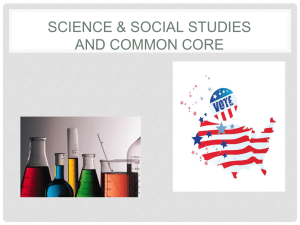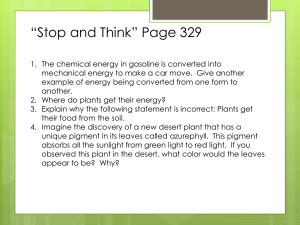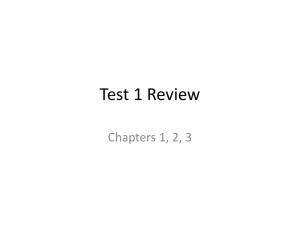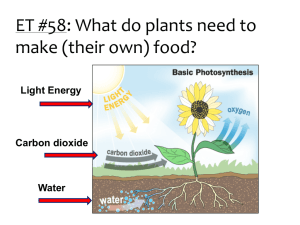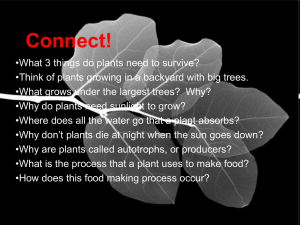Lesson Overview
advertisement
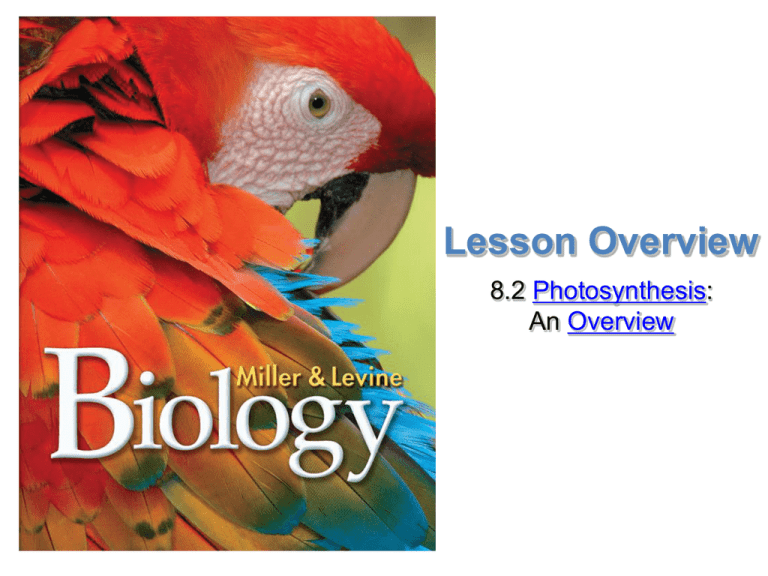
Lesson Overview Photosynthesis: An Overview Lesson Overview 8.2 Photosynthesis: An Overview Lesson Overview Photosynthesis: An Overview Light Energy from the sun travels to Earth in the form of light. Sunlight is a mixture of different wavelengths, many of which are visible to our eyes and make up the visible spectrum. Lesson Overview Photosynthesis: An Overview Pigments Plants gather the sun’s energy with light-absorbing molecules called pigments. The plants’ principal pigment is chlorophyll. Lesson Overview Pigments Photosynthesis: An Overview Lesson Overview Photosynthesis: An Overview Chloroplasts Chloroplasts contain saclike photosynthetic membranes called thylakoids, which are interconnected and arranged in stacks known as grana. The fluid portion outside of the thylakoids is known as the stroma. Lesson Overview Photosynthesis: An Overview Energy Collection When chlorophyll absorbs light, a large fraction of the light energy is transferred to electrons. These high-energy electrons make photosynthesis work. Lesson Overview Photosynthesis: An Overview High-Energy Electrons The high-energy electrons produced by chlorophyll are highly reactive and require a special “carrier.” Think of a high-energy electron as being similar to a hot potato. If you wanted to move the potato from one place to another, you would use an oven mitt —a carrier—to transport it. Plants use electron carriers to transport high-energy electrons from chlorophyll to other molecules. Lesson Overview Photosynthesis: An Overview High-Energy Electrons NADP+ (nicotinamide adenine dinucleotide phosphate) is a carrier molecule. NADP+ accepts and holds two high-energy electrons, along with a hydrogen ion (H+). In this way, it is converted into NADPH. The NADPH can then carry the high-energy electrons to chemical reactions elsewhere in the cell. Lesson Overview Photosynthesis: An Overview An Overview of Photosynthesis Photosynthesis uses the energy of sunlight to convert water and carbon dioxide into high-energy sugars and oxygen. In symbols: 6 CO2 + 6 H2O C6H12O6 + 6 O2 In words: Carbon dioxide + Water Sugars + Oxygen Lesson Overview Photosynthesis: An Overview An Overview of Photosynthesis Plants use the sugars generated by photosynthesis to produce complex carbohydrates such as starches, and to provide energy for the synthesis of other compounds, including proteins and lipids. Lesson Overview Photosynthesis: An Overview Light-Dependent Reactions Photosynthesis involves two sets of reactions. The first set of reactions is known as the light-dependent reactions because they require the direct involvement of light and light-absorbing pigments. Lesson Overview Photosynthesis: An Overview Light-Dependent Reactions The light-dependent reactions use energy from sunlight to produce ATP and NADPH. These reactions take place within the thylakoid membranes of the chloroplast. Water is required as a source of electrons and hydrogen ions. Oxygen is released as a byproduct. Lesson Overview Photosynthesis: An Overview Light-Independent Reactions During light-independent reactions, ATP and NADPH molecules produced in the light-dependent reactions are used to produce high-energy sugars from carbon dioxide. No light is required to power the light-independent reactions. The light-independent reactions take place outside the thylakoids, in the stroma. Lesson Overview Photosynthesis: An Overview Lesson Overview Questions Photosynthesis: An Overview 1. In the process of photosynthesis, plants convert the energy of sunlight into chemical energy stored in the bonds of _________. Carbohydrates 2. Photosynthetic organisms capture energy from sunlight with ________. Pigment 3. The plant’s principal pigment is _______. Chlorophyll 4. Photosynthesis takes place in ___________. Chloroplasts 5. T or F - Chloroplasts contain an abundance of saclike photosynthetic membranes called thylakoids. TRUE 6. T or F - The fluid portion of the chloroplast, outside of the thylakoids, is known as the matirx. FALSE - STROMA 7. Raising the energy levels of electrons on the chlorophyll molecule, light energy can produce a steady supply of _______________electrons, which is what makes photosynthesis work. High Energy Lesson Overview Photosynthesis: An Overview Questions 8. An electron _________is a compound that can accept a pair of high-energy electrons and transfer them, along with most of their energy, to another molecule. Carrier 9. NADP+ is converted to ______________as it accepts and transfers electrons to chemical reactions elsewhere in the cell. NADPH 10. What is the overall equation of photosynthesis? 6CO2 + 6H2O + light C6H12O6 + 6O2 11. The light- ______________reactions produce ATP and NADPH from sunlight in the thylakoid membranes. Dependent 12. The light-______________t reaction in the stroma, sugars are created from carbon dioxide using the ATP and NAPH from the light-dependent reactions. Independent Lesson Overview Photosynthesis: An Overview Photosynthesis REVIEW Lesson Overview Photosynthesis: An Overview Photosynthesis REVIEW Lesson Overview Photosynthesis: An Overview Photosynthesis REVIEW Lesson Overview Photosynthesis: An Overview What is the equation for photosynthesis?



